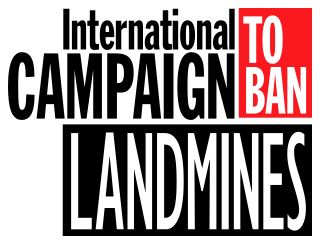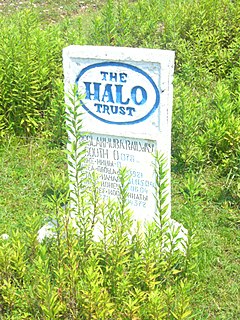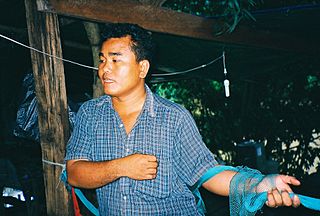External links
| This explosives-related article is a stub. You can help Wikipedia by expanding it. |
The Type 3 mine was a Japanese ceramic cased landmine used during the Second World War. The mine contained approximately 3 kg of explosive and had a diameter of 27 cm. A wooden landmine using the same fuse was also produced towards the end of the war.
| This explosives-related article is a stub. You can help Wikipedia by expanding it. |

A land mine is an explosive device concealed under or on the ground and designed to destroy or disable enemy targets, ranging from combatants to vehicles and tanks, as they pass over or near it. Such a device is typically detonated automatically by way of pressure when a target steps on it or drives over it, although other detonation mechanisms are also sometimes used. A land mine may cause damage by direct blast effect, by fragments that are thrown by the blast, or by both.

The International Campaign to Ban Landmines (ICBL) is a coalition of non-governmental organizations whose stated objective is a world free of anti-personnel mines and cluster munitions, where mine and cluster munitions survivors see their rights respected and can lead fulfilling lives.

The HALO Trust is a non-political and non-religious registered British charity and American non-profit organization which removes debris left behind by war, in particular land mines. With about 6,000 deminers worldwide, HALO's largest operation is in Afghanistan, where the organization operates as an implementing partner of the Mine Action Programme for Afghanistan (MAPA).

Unexploded ordnance, unexploded bombs (UXBs), or explosive remnants of war (ERW) are explosive weapons that did not explode when they were employed and still pose a risk of detonation, sometimes many decades after they were used or discarded. UXO does not always originate from wars; areas such as military training grounds can also hold significant numbers, even after the area has been abandoned. UXO from World War I continue to be a hazard, with poisonous gas filled munitions still a problem. When unwanted munitions are found, they are sometimes destroyed in controlled explosions, but accidental detonation of even very old explosives also occurs, sometimes with fatal results.

The Convention on the Prohibition of the Use, Stockpiling, Production and Transfer of Anti-Personnel Mines and on their Destruction, known informally as the Ottawa Treaty, the Anti-Personnel Mine Ban Convention, or often simply the Mine Ban Treaty, aims at eliminating anti-personnel landmines (AP-mines) around the world. To date, there are 164 state parties to the treaty. One state has signed but not ratified the treaty, while 32 UN states, including the United States, Russia, China and India are non-signatories, making a total of 33 United Nations states not party.

Minelaying is the act of deploying explosive mines. Historically this has been carried out by ships, submarines and aircraft. Additionally, since World War I the term minelayer refers specifically to a naval ship used for deploying naval mines. "Mine planting" was the term for installing controlled mines at predetermined positions in connection with coastal fortifications or harbor approaches that would be detonated by shore control when a ship was fixed as being within the mine's effective range.

Survivor Corps is a global network of survivors helping survivors to recover from war, rebuild their communities, and break cycles of violence. The organization currently operates programs in Albania, Armenia, Azerbaijan, Bosnia-Herzegovina, Burundi, Colombia, Croatia, El Salvador, Ethiopia, Georgia, Jordan, Kosovo, Macedonia, Montenegro, Serbia, Uganda, Rwanda, the United States and Vietnam.

Demining or mine clearance is the process of removing land mines from an area. There are two distinct types of mine detection and removal: military and humanitarian.
The United Nations Convention on Certain Conventional Weapons, concluded at Geneva on October 10, 1980, and entered into force in December 1983, seeks to prohibit or restrict the use of certain conventional weapons which are considered excessively injurious or whose effects are indiscriminate. The full title is Convention on Prohibitions or Restrictions on the Use of Certain Conventional Weapons Which May Be Deemed to Be Excessively Injurious or to Have Indiscriminate Effects. The convention covers landmines, booby traps, incendiary weapons, blinding laser weapons and clearance of explosive remnants of war.
Cambodia is a country located in South East Asia that has a major problem with landmines, especially in rural areas. This is the legacy of three decades of war which has taken a severe toll on the Cambodians; it has some 40,000 amputees, which is one of the highest rates in the world. The Cambodian Mine Action Centre (CMAC) estimates that there may be as many as four to six million mines and other pieces of unexploded ordnance in Cambodia.
A mine clearance agency, or demining agency, is an organization involved in removal of landmines and unexploded ordnance (UXO) for military, humanitarian, or commercial reasons. Demining includes mine clearance, as well as surveying, mapping and marking of hazardous areas.

Aki Ra is a former Khmer Rouge conscripted child soldier who works as a deminer and museum curator in Siem Reap, Cambodia. He has devoted his life to removing landmines in Cambodia and to caring for young landmine victims. Aki Ra states that since 1992 he has personally removed and destroyed as many as 50,000 landmines, and is the founder of the Cambodian Landmine Museum.

The Type 93 mine was a circular Japanese landmine used during the Second World War. It entered service in 1933. It used a simple fuze with a variable activation pressure, achieved through the use of different thickness shear wires. The main charge could be supplemented with additional explosives buried under the mine.

A minimum metal mine is a land mine that is designed to use the smallest amount of metal possible in its construction. Typically, the only metal components are located inside the fuze mechanism which triggers detonation. Both minimum metal anti-tank and anti-personnel mines exist. Some designs contain virtually no metal at all e.g. less than a gram. This is achieved by encasing the explosive charge in a plastic, wooden, or glass body, with metallic components limited to the few small parts in the fuze which can not easily be made from other materials, such as the spring, striker tip, and shear pin. Minimum metal mines are extremely difficult to detect using conventional metal mine detectors and usually require modern techniques, such as robotic Multi Period Sensing (MPS) equipment, to identify, but it is still too difficult to find non-metallic mines. These techniques are usually restricted to well-funded international mine clearing organizations and major militaries, making minimum metal mines especially pernicious where they are encountered.
Chechnya is the most land mine-affected region worldwide.
Mine action is a combination of humanitarian aid and development studies that aim to reduce the social, economic and environmental impact of landmines and the explosive remnants of war (ERW).

The United Nations Mine Action Service (UNMAS) is a service located within the United Nations Department of Peacekeeping Operations that specializes in coordinating and implementing activities to limit the threat posed by mines, explosive remnants of war and improvised explosive devices.
Since the outbreak of the First Indochina War in 1946 and later the bloodier Second Indochina War of the 1960s and 1970s, countless numbers of land mines have been planted in what is now the Socialist Republic of Vietnam. Many of these devices that did not detonate at some point or another remain a very dangerous menace that continues plaguing the country and surrounding areas.

Batman: Death of Innocents: the Horror of Landmines is a "landmine awareness" and "humanitarian comic book" published by DC Comics in 1996. The graphic novel was authored by Dennis O'Neil, Joe Staton, Bill Sienkiewicz, and Ian Laughlin. O'Neill wrote the story, Staton was the penciller, Sienkiewicz was the inker, and Laughlin was the colorist. The purpose for publishing this particular Batman comic book was to teach the people of the United States regarding the dangers and consequences of landmines worldwide, left active in countries that had been under war. The publication of this Batman comic book title was influenced by two other similarly themed comic books featuring Superman and Wonder Woman, namely Superman: Deadly Legacy and Superman and Wonder Woman - the Hidden Killer.

Superman and Wonder Woman – the Hidden Killer is a special-edition “humanitarian comic book” featuring Superman and Wonder Woman that promotes “landmine awareness” among children, particularly from countries where there are active landmines after war. The free comic book was published from 1993 through 1999 by DC Comics, the United States Department of Defense, the Mine Action Center (MAC), the United Nations International Children's Emergency Fund (UNICEF), and participating non-governmental organizations (NGOs). In the comic book, Superman and Wonder Woman are featured as educators who are teaching children about the dangers of landmines.